Source - http://www.archaeology.org/issues/61-features/264-top-10-2012-intro
Maya Sun God Masks
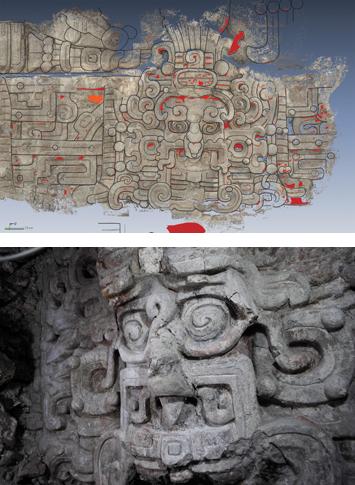
(Courtesy Stephen Houston, Brown University
El Zotz, Guatemala - Archaeologists have unearthed a spectacular series of stucco masks at the Maya city of El Zotz. Dating to between A.D. 350 and 400, the five-foot-tall masks decorated a temple atop El Diablo pyramid, which commemorates the founder of the city’s royal dynasty. The masks were painted bright red and depict several deities, including the sun god. They show different phases of the sun as it makes its way across the sky. Between the gods are representations of Venus and other planets. “It’s a celestial symphony,” says Brown University archaeologist Stephen Houston, who co-led the excavation with Edwin Roman of the University of Texas. “The sun is closely associated with Maya kingship, and these images celebrate that link.” (Eric A. Powell)
Neanderthal Medicine Chest
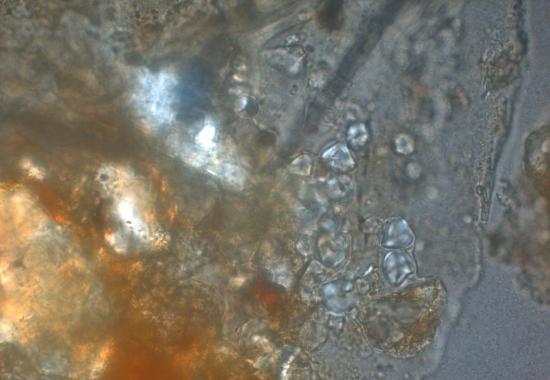
(Courtesy CSIC Comunicación)
Piloña, Asturias, Spain - The latest frontier in Neanderthal research is not the artifacts they left behind or remnants of their DNA. Rather, it is the gunk that stuck to their teeth. Karen Hardy of the Catalan Institution for Research and Advanced Studies in Spain and Stephen Buckley of the University of York in the United Kingdom used a variety of chemical analyses that helped uncover the first evidence that Neanderthals consumed medicinal plants. The team examined the chemicals embedded in the calcified plaque on the teeth of five Neanderthals dated to between 50,600 and 47,300 years ago from El Sidrón Cave in Spain. The analyses showed that the Neanderthals inhaled wood smoke, probably from a campfire, and that they had eaten cooked plant foods as well as the bitter-tasting medicinal plants chamomile and yarrow. “They had to have a body of knowledge about plants to select yarrow and chamomile,” says Hardy. The same analyses used in this study have the potential to be used on almost any tooth. According to Hardy, they could be used to provide direct evidence of hominin diets going back millions of years. (Zach Zorich)
First Use of Poison
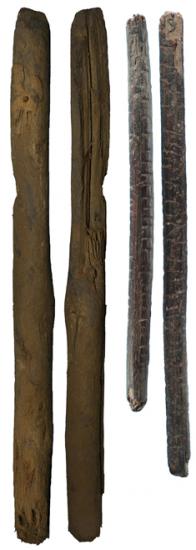
(Courtesy of Francesco d’Errico and Lucinda Backwell)
Lebombo Mountains, KwaZulu-Natal, South Africa - A notched wooden stick from South Africa’s Border Cave dating to 24,000 years ago contains the earliest evidence of humans using poison. The artifact was found in the 1970s, but new chemical analyses conducted by a research team led by Francesco d’Errico of Bordeaux University in France revealed trace amounts of substances from poisonous castor beans. The stick may have been used to apply poison to arrowheads just as a culture of modern-day hunter-gatherers called the San does today in southern Africa. According to d’Errico, poison is an important part of traditional San hunting methods because their bone-tipped arrows usually don’t cause enough damage to kill large prey on their own. The poison applicator is just one of several artifacts, some dating to as early as 44,000 years ago, that resemble objects used by the San. Others include a digging stick, ostrich eggshell beads, carved pig tusks, bone arrowheads, and a lump of beeswax. D’Errico’s team believes the artifacts indicate that San culture emerged about 44,000 years ago, making these artifacts the earliest link to a culture of modern humans. The findings also clarify why it is thought that modern human behavior—loosely defined as making objects that show symbolic thinking or complex hunting methods—may have begun in Africa. Earlier evidence of such behavior has been uncovered in South Africa at sites such as Blombos Cave and Pinnacle Point, where beads, pigments, and artifacts related to fishing that date to more than 100,000 years ago have been found. Those types of artifacts, however, seem to disappear from the archaeological record at later times, indicating that those cultures may have died out. The poison and other artifacts from Border Cave, on the other hand, are the earliest that can be directly connected to an extant culture. “We think of modern humans as people who are able to change their culture all the time,” says d’Errico, “but when we have a very effective cultural adaptation, we don’t need to change.” (Zach Zorich)
Aztec Ritual Burial
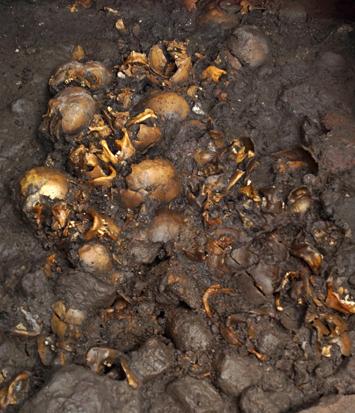
(Courtesy Melitón Tapia/INAH)
Mexico City, Mexico - Mexico’s Templo Mayor was a center of Aztec civic life before the Spanish conquest. In 2012, archaeologists learned more about its importance for civic death. In a grisly discovery, they excavated more than 1,000 tightly packed human bones, among them 45 skulls and 250 jawbones. There was only one complete, undisturbed skeleton, in a separate cache—a woman, lying face down, her left hand resting enigmatically on her back and her right on her abdomen. She was surrounded by more bones, including at least 10 skulls, plus ceramic and charcoal offerings. Raúl Barrera of Mexico’s National Institute of Anthropology and History says the larger cache was probably a “closure deposit” buried as a kind of consecration after an important building phase around 1479. Because the bones are so crowded together, he says, they must have “been buried elsewhere, exhumed, and reburied here.” But not all of them. Barrera’s team excavated a volcanic slab used for human sacrifices, beneath which they found five more skulls with gaping perforations. The victims may have died on the sacrifice stone, but the holes were probably for mounting their skulls on a stake known as a tzompantli. It may all seem macabre to us, but to the Aztecs, this charnel house was, according to Barrera, “where the earthly and heavenly realms communicated with each other.” (Roger Atwood)
Caesar’s Gallic Outpost
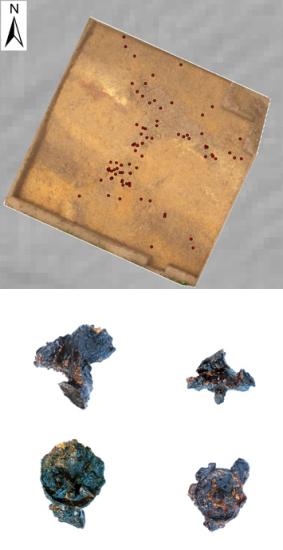
(Courtesy © Sabine Hornung, Arno Braun)
Hermeskeil, Germany - The discovery of a collection of 75 sandal nails has led German archaeologists to the rare identification of a temporary Roman military camp near the town of Hermeskeil, near Trier, in southwestern Germany. Directed by Sabine Hornung, an archaeologist at the Johannes Gutenberg University Mainz, the team uncovered the camp’s main gate, the flat stones that once paved its entrance, and grindstones used by the Romans to mill grain. Scattered among the paving stones were bits of metal that the team quickly identified as sandal nails. Some of the nails were quite large—as much as an inch across— and had distinct workshop marks of a type used by the army, “a sort of cross with little dots” or studs, says Hornung. “That told us it was definitely a military camp,” she adds. Ground-penetrating radar surveys showed that the camp, built to house soldiers on the move, sprawls over nearly 65 acres. Excavated pottery sherds, both from local and imported Roman wares, date the camp to the 50s b.c., the period Julius Caesar wrote about in his memoir, The Gallic Wars. From 58 to 50 b.c., Caesar waged three campaigns against the Gallic tribes and their powerful leaders for control over the territory of Gaul, primarily modern-day France and Belgium. Taking account of the camp’s date and the distinctly Caesarean sandal nails, Hornung says, “It’s very probable it is a camp built by Julius Caesar’s legions.” The camp sits just a few miles away from the so-called “Hunnenring,” a major Celtic hill fort with 30-foot-high walls. Such centers of military and political power made Gaul an attractive target for the Romans. By focusing their efforts on these regional centers, the Romans could exert sustained and concentrated pressure on local leaders instead of having to chase down the scattered tribes living in the German forests further to the east. Eventually this pressure, and the military victories achieved by Caesar and his legions, resulted in the conquest of Gaul and cleared the way for the general to assume sole control of the Roman Republic. For Gunter Moosbauer, an archaeologist at Germany’s University of Osnabrück familiar with the discovery, the finds from Hermeskeil are an “archaeological thrill.” He says, “Roman field campaigns lasted just a few months, and to find one of their temporary camps is really rare." (Andrew Curry)
PART. 2